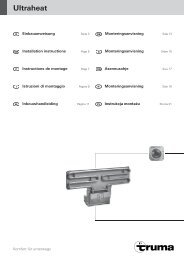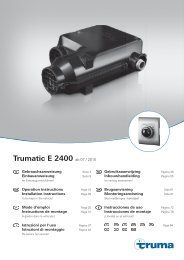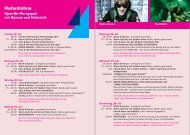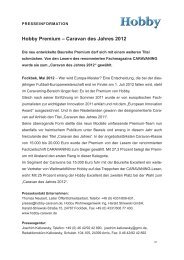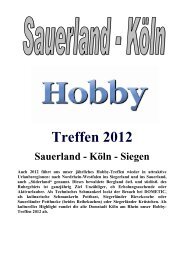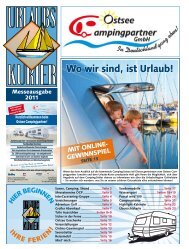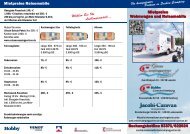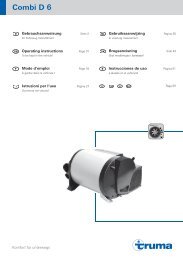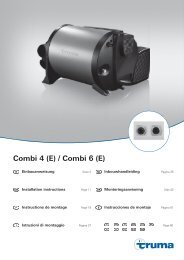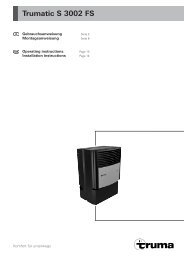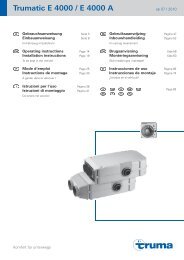Trumatic S 2200 / S 2200 P - Ostsee Campingpartner
Trumatic S 2200 / S 2200 P - Ostsee Campingpartner
Trumatic S 2200 / S 2200 P - Ostsee Campingpartner
You also want an ePaper? Increase the reach of your titles
YUMPU automatically turns print PDFs into web optimized ePapers that Google loves.
Important operating notes<br />
1. The heat exchanger, the exhaust and combustion air<br />
ducts and all connections must be checked by an expert<br />
at regular intervals, and always after loud combustion<br />
(misfiring).<br />
The exhaust duct and the combustion air duct must<br />
– be firmly attached to the heater and the cowl without<br />
leaks,<br />
– consist of one piece (not extended),<br />
– be routed without cross-section narrowing and rising<br />
over their entire length,<br />
– be firmly attached with several clamps together with<br />
the ÜR air duct.<br />
No objects must be placed onto the exhaust and combustion<br />
air ducts, since this could lead to damage.<br />
Heaters with wrongly fitted or damaged exhaust<br />
and combustion air ducts or damaged heat exchangers<br />
must not continue to be used!<br />
2. Under no circumstances obstruct the upper hot air<br />
outlet on the heater. Never hang clothes or washing or such<br />
to dry directly in front of the heater or on it. Misusing the<br />
heater in this way could seriously damage your heater though<br />
overheating. Never put flammable objects near the heater!<br />
Please observe this point for your own safety.<br />
10<br />
Attention: Due to the design, the heater front case<br />
will become hot during operation. The operator is<br />
obliged to ensure that due care is taken to protect<br />
third parties (small children in particular).<br />
3. Always observe the following when exhaust gas and<br />
combustion air are routed through the side wall:<br />
The cowls must be installed at the specified height (refer to<br />
installation instructions). For duct lengths of 35 cm and longer,<br />
you must install a double support DSW.<br />
The lids to cover the cowls (accessories) must be attached<br />
when the heater is not in use.<br />
4. Always observe the following when exhaust gas is routed<br />
via the roof:<br />
If the caravan has a double skin, the exhaust gas cowl must<br />
always pass through this as well. For this purpose use the<br />
cowl leadthrough UEK (part no. 30630-04)!<br />
If the heater keeps going out in extremely windy locations,<br />
we recommend the use of an AKV cowl extension (part no.<br />
30010-20800). This must be removed whilst the vehicle is in<br />
motion so that it is not lost (risk of accident).<br />
For winter camping and long-term camping we recommend<br />
the SKV cowl extension kit (part no. 30690-00) that can be<br />
screwed to the cowl section. This must be removed whilst the<br />
vehicle is in motion so that it is not lost (risk of accident).<br />
5. The combustion air intake under the vehicle floor must be<br />
freed of dirt and slush. The intake opening of the heater is<br />
therefore never to be in the spray area of the wheels, apply a<br />
spray guard, if necessary.<br />
Servicing<br />
In the event of a fault contact the Truma Service outlet in the<br />
first instance (see Truma Service Booklet or www.truma.com).<br />
Attention: Despite careful manufacture, the heating<br />
system may contain sharp-edged components, and<br />
protective gloves should always be worn when carrying<br />
out any maintenance or cleaning work!<br />
Changing battery on the automatic ignitor<br />
If sparking is inaudible, or takes place at intervals of more than<br />
a second, the battery needs replacing.<br />
Replace batteries only if the heater is switched off. Insert a<br />
new battery before the start of the heating season! Dispose of<br />
old battery properly!<br />
Raise the battery compartment cover and replace battery. Pay<br />
attention to plus / minus signs. Close compartment cover.<br />
Only use temperature resistant (+70 °C), leakproof Mignon<br />
batteries (LR 6, AA, AM 3, part no. 30030-99200), other batteries<br />
could caus operational faults!<br />
Before scrapping the automatic ignition, remove battery<br />
and dispose of properly!<br />
Cleaning (only when the heater is switched off!)<br />
We recommend removing the dust which has collected on the<br />
heat exchanger, base plate and on the fan wheel of the<br />
Trumavent warm air system at least once a year, before the<br />
heating season starts. Clean the fan wheel carefully using a<br />
brush or toothbrush.<br />
General safety notes<br />
The use of upright gas cylinders from which gas is taken in<br />
the gas phase is mandatory for the operation of gas regulators,<br />
gas equipment and gas systems. Gas cylinders from<br />
which gas is taken in the liquid phase (e.g. for fork lifts) must<br />
not be used, since they would result in damage to the gas<br />
system.<br />
If the gas system is leaking or if there is a smell of gas:<br />
– extinguish all open flames<br />
– open windows and door<br />
– close all quick-acting valves and gas cylinders<br />
– do not smoke<br />
– do not activate any electric switches<br />
– ask an expert to inspect the entire system!<br />
Repairs may only be carried out by an expert.<br />
A new O-ring must always be installed after dismantling the<br />
exhaust duct!<br />
Guarantee claims, warranty claims and acceptance of liability<br />
will be ruled out in the event of the following:<br />
– modifications to the unit (including accessories),<br />
– modifications to the exhaust duct and the cowl,<br />
– failure to use original Truma parts as<br />
replacement parts and accessories,<br />
– failure to follow the installation and operating instructions.<br />
It also becomes illegal to use the appliance, and in some<br />
countries this even makes it illegal to use the vehicle.<br />
The gas supply’s operating pressure (30 mbar) must be the<br />
same as the unit’s operating pressure (see type plate).



